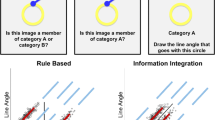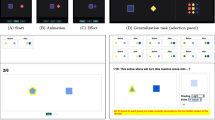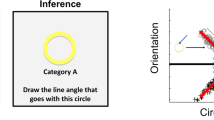Abstract
In four experiments, the question of how the causal structure of features affects the creation of new categories was examined. Features of exemplars to be sorted were related in a single causal chain (causal chain), were caused by the same factor (common cause), or caused the same effect (common effect). The results showed that people are more likely to rely on common-cause or common-effect background knowledge than on causal-chain background knowledge in category construction. Such preferences suggest that the common-cause or the common-effect structures are considered more natural conceptual structures.
Similar content being viewed by others
References
Ahn, W. (1990a). Effects of background knowledge on family resemblance sorting. InProceedings of the 12th Annual Conference of the Cognitive Science Society (pp. 149–156). Hillsdale, NJ: Erlbaum.
Ahn, W. (1990b).A two-stage model of category construction. Unpublished doctoral dissertation, University of Illinois, Urbana.
Ahn, W. (1991). Effects of background knowledge on family resemblance sorting and missing features. InProceedings of the 13th Annual Conference of the Cognitive Science Society (pp. 203–208). Hillsdale, NJ: Erlbaum.
Ahn, W., &Medin, D. L. (1992). A two-stage model of category construction.Cognitive Science,16, 81–121.
Bloom, P. (1996). Intention, history, and artifact concepts.Cognition,60, 1–29.
Brooks, L. R., & Wood, T. (1997, November).Identification in service of use: Characteristic of everyday concept learning. Paper presented at the 38th annual meeting of the Psychonomic Society, Philadelphia.
Byrne, R. M. J. (1997). Cognitive processes in counterfactual thinking about what might have been. In D. Medin (Ed.),The psychology of learning and motivation (Vol. 37, pp. 105–154). San Diego: Academic Press.
Carey, S. (1985).Conceptual change in childhood. Cambridge, MA: Plenum.
Gelman, S. A., &Kalish, C. W. (1993). Categories and causality. In R. Pasnak & M. L. Howe (Eds.),Emerging themes in cognitive development (Vol. 2). New York: Springer-Verlag.
Imai, S., &Garner, W. R. (1965). Discriminability and preference for attributes in free and constrained classification.Journal of Experimental Psychology,69, 596–608.
Keil, F. C. (1981). Constraints on knowledge and cognitive development.Psychological Review,88, 197–227.
Keil, F. C. (1989).Concepts, kinds, and cognitive development. Cambridge, MA: MIT Press.
Lassaline, M. E., &Murphy, G. L. (1996). Induction and category coherence.Psychonomic Bulletin & Review,3, 95–99.
Markman, E. M. (1989).Categorization and naming in children. Cambridge, MA: MIT Press.
Martin, R. C., &Caramazza, A. (1980). Classification in well-defined and ill-defined categories: Evidence for common processing strategies.Journal of Experimental Psychology: General,109, 320–353.
McNemar, Q. (1947). Note on the sampling error of the difference between correlated proportions or percentages.Psychometrika,12, 153–157.
Medin, D. L., &Ortony, A. (1989). Psychological essentialism. In S. Vosniadou & A. Ortony (Eds.),Similarity and analogical reasoning (pp. 179–196). New York: Cambridge University Press.
Medin, D. L., &Shoben, E. J. (1988). Context and structure in conceptual combination.Cognitive Psychology,20, 158–190.
Medin, D. L., Wattenmaker, W. D., &Hampson, S. E. (1987). Family resemblance, conceptual cohesiveness, and category construction.Cognitive Psychology,19, 242–279.
Murphy, G. L., &Allopenna, P. D. (1994). The locus of knowledge effects in concept learning.Journal of Experimental Psychology: Learning, Memory, & Cognition,20, 904–919.
Murphy, G. L., &Medin, D. L. (1985). The role of theories in conceptual coherence.Psychological Review,11, 299–339.
Nakamura, G. V. (1985). Knowledge-based classification of illdefined categories.Memory & Cognition,13, 377–384.
Nosofsky, R. M., Palmeri, T. J., &McKinley, S. C. (1994). Rule-plusexception model of classification learning.Psychological Review,101, 53–79.
Pazzani, M. J. (1991). Influence of prior knowledge on concept acquisition: Experimental and computational results.Journal of Experimental Psychology: Learning, Memory, & Cognition,17, 416–432.
Regehr, G., &Brooks, L. R. (1995). Category organization in free classification: The organizing effect of an array of stimuli.Journal of Experimental Psychology: Learning, Memory, & Cognition,21, 347–363.
Rosch, E., &Mervis, C. B. (1975). Family resemblance: Studies in the internal structure of categories.Cognitive Psychology,7, 573–605.
Smith, E. E., &Medin, D. L. (1981).Categories and concepts. Cambridge, MA: Harvard University Press.
Smith, L. B. (1981). Importance of the overall similarity of objects for adults’ and children’s classifications.Journal of Experimental Psychology: Human Perception & Performance,1, 811–824.
Spalding, T. L., &Murphy, G. L. (1996). Effects of background knowledge on category construction.Journal of Experimental Psychology: Learning, Memory, & Cognition,22, 525- 538.
Ward, T. B., &Scott, J. (1987). Analytic and holistic modes of learning family-resemblance concepts.Memory & Cognition,15, 42–54.
Wattenmaker, W. D. (1995). Knowledge structures and linear separability: Integrating information in object and social categorization.Cognitive Psychology,28, 274–328.
Wellman, H. M. (1990).The child’s theory of mind. Cambridge, MA: MIT Press.
Author information
Authors and Affiliations
Corresponding author
Additional information
This project was supported partly by National Science Foundation Grant NSF-SBR 9515085 and partly by National Institute of Mental Health Grant RO1 MH57737, awarded to the author.
Rights and permissions
About this article
Cite this article
Ahn, WK. Effect of causal structure on category construction. Mem Cogn 27, 1008–1023 (1999). https://doi.org/10.3758/BF03201231
Received:
Accepted:
Published:
Issue Date:
DOI: https://doi.org/10.3758/BF03201231




